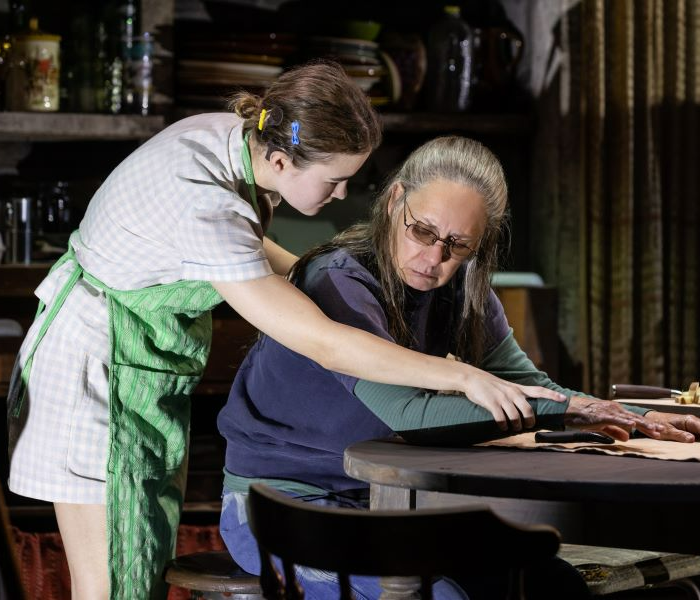Translate Page

The Quiet Place star and her colleagues Andrew Morrill and Levi Holloway on expanding opportunities for Deaf artists
---
Although Millicent Simmonds fell in love with acting through theatre, appearing as Puck in her elementary school production of A Midsummer Night's Dream before landing roles in the films Wonderstruck and both installments of A Quiet Place, she worried Broadway wasn't a possibility for her as a Deaf artist. After all, only a handful of Broadway shows have featured Deaf actors performing in American Sign Language (ASL), notably both mountings of Mark Medoff's Children of a Lesser God; Deaf West Theatre's Big River and Spring Awakening; a 2019 production of King Lear and last year's revival of for colored girls…
Then director Joe Mantello reached out to Simmonds about joining Grey House, Levi Holloway's new psychological thriller at the Lyceum Theatre about a stranded couple (Tatiana Maslany and Paul Sparks) who seeks shelter in an isolated cabin with an eerie family led by a mysterious matriarch (Laurie Metcalf). Simmonds plays Bernie, one of several young women living in the house who communicate in their own cryptic language, a combination of signing and speech.
As the cofounder and co-artistic director of Neverbird Project, a Chicago-based Deaf and hearing youth theatre company, and the former head of the Sign/Voice theatre program at Chicago's Bell Elementary, Holloway has a long history of collaborating with Deaf actors. "I don't write for Deaf artists, I write of them," he says. "I think that distinction is important because I wouldn't dare take cultural space. But I see the opportunity to create roles for artists who might otherwise not be awarded them."
When writing Grey House, which premiered at Chicago's A Red Orchid Theatre in 2019, Holloway was deliberate in making Bernie being Deaf part of but not central to the plot. "I don't think inclusion works if you point to it," he says. "I think that can cheapen it. You can reduce it to its function. Bernie just happens to be Deaf. The fact that these other family members learned ASL is an expression of their love and devotion."
To incorporate ASL into Grey House, Andrew Morrill, a Deaf actor who has performed with Deaf West Theatre and the National Theatre of the Deaf, was hired as the Director of Artistic Sign Language. "The challenging part was giving love and respect to the language and making sure that the actors really understood the translations," Morrill says through an interpreter. "It's less about teaching them the actual movements of the sign but making sure that they understand the concepts behind the translation, because [aside from Simmonds] they're new to this language."
Morrill also had to do research to ensure the sign language was authentic to the late 1970s when the play is set. "ASL has changed over time due to political, social, environmental and economic factors," he explains. "We do not have a written form of ASL, so we don't have a lot of documentation of its evolution. I had to ask a lot of people for help finding videos from the '70s to see good examples of ASL back then."
While Simmonds is thrilled to be making her Broadway debut in Grey House, which explores misogyny and inherited trauma through a horror lens, she thinks opportunities for Deaf actors are too few and far between. "We need to be working together, taking the time to brainstorm about possibilities, about which shows are in development," she says through an interpreter.
Morrill agrees. "When people talk about diversity, they're usually not including disability," Morrill says. "It's typically about race or gender or other demographics. I think we need to transform that concept, and I think that we need to make accessibility integral practice for productions."
To that end, Grey House is offering select performances with ASL interpretation and open captioning. But Morrill wants the theatre industry as a whole to do more than just "check the accessibility box" for both artists and audiences. "I think producers need to be talking about accessibility on day one—how can we make the show accessible for all of these groups and what's the budget for it?"
As a veteran of Chicago's scrappy storefront theatre scene, Holloway is familiar with accessibility funding woes. Working on Grey House, he's been "blown away" by the efforts of the producers and creative team to make the show inclusive.
"I think that if theatre is for everybody, it should be of and for everyone," he says. "Accessibility has to be a line item in any budget. If the work is Deaf and hearing integrated on stage, how do we bring that into the design and into the producing space?"
Simmonds hopes Grey House will lead to more opportunities for Deaf actors on Broadway. "I think it's important for audiences and directors and producers to see that we can collaborate together," she says. "We don't need to be segregated communities. Hopefully, this will encourage the industry to bring in Deaf talent as part of the creative process."
---
Top image: Millicent Simmonds and Laurie Metcalf in Grey House on Broadway. Photo by MurphyMade.
TDF MEMBERS: At press time, discount tickets were available for Grey House. The show is also frequently available at our TKTS Discount Booths.